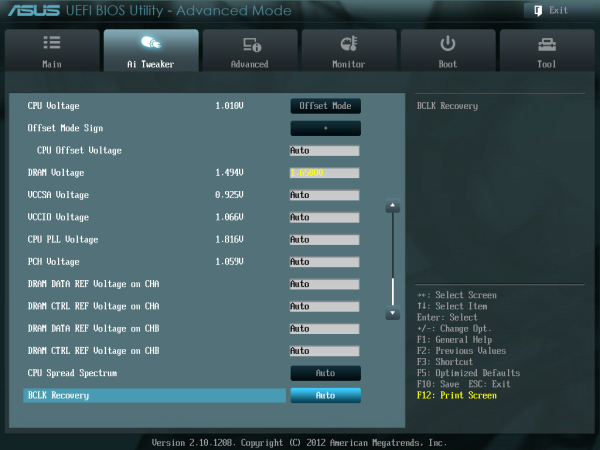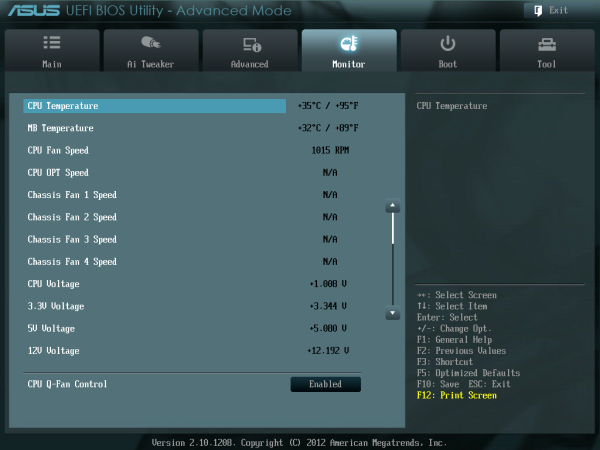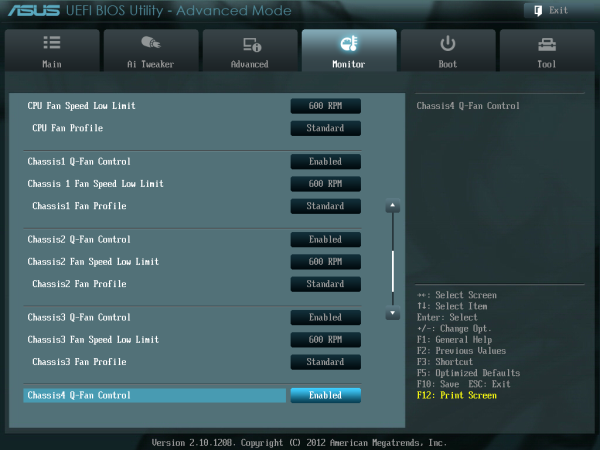ASUS P8Z77-V Deluxe Review - Know Your SKU
by Ian Cutress on May 12, 2012 8:45 AM EST- Posted in
- Motherboards
- Asus
- Z77
ASUS P8Z77-V Deluxe BIOS
In the past, when you had seen one BIOS then you had generally seen them all - white text on blue screens (or white on black if you were lucky). Now that we are firmly in an era of graphical interfaces and user operability, as users we get to see and play with the combination of designs that teams and BIOS engineers can envisage. Leading the field during P67 was ASUS, but now with Z68 and X79 out of the way, MSI and Gigabyte have been hot on their heels in an attempt to offer a superior experience.
The problem with consecutive iterations of innovation is how to innovate next - more functionality, or improvements on current functionality? ASUS will perhaps have to invest in deciding which direction to take over the next few chipsets - but nevertheless, the BIOS we have access to today is still very well thought out, easy to use, and one of the better graphical BIOS implementations for users and enthusiasts to enjoy.
The initial screen as we may all know by now for ASUS products is the EZ Mode - showing everything a user needs to know about what they have just bought or are using. We have the board model and BIOS version (always important to know without opening up a case to find out or loading CPU-Z), CPU type and speed, memory amount and speed, CPU/chipset temperatures, as well as voltages and fan speeds. For ease of use, system performance can be adjusted for low power, normal, or high performance. The boot priority is also changed by dragging drives into their appropriate positions. Pressing F3 will bring up shortcuts to the main sections in Advanced Mode, whereas F8 offers a one-time boot choice for the next boot (useful for installing OSes in my case).
Advanced mode is where the meat of the BIOS action happens as per usual, with AI Tweaker holding all the overclocking secrets a general enthusiast could want. Users coming from ROG boards will find far fewer options on the Deluxe than on ROG boards, as the Deluxe focuses on delivering secure performance rather than bleeding edge - this may discourage a few extreme (sub-zero) overclockers, but chances are those users will be heading for ROG anyway. For the rest of us, the main option is 'AI Overclock Tuner', which offers Auto/Manual/XMP options.
Under XMP, the following options are opened up, with 'core ratio limit' determining the multiplier. The BCLK Frequency is also adjustable. When pushing the CPU above 4.6 GHz, it is recommended that Internal PLL Overvoltage be set to enabled. XMP is automatically set in this mode, including memory strap, voltage and subtimings. These can also all be adjusted as required.
Voltages are set below the main settings, and the DIGI+ VRM option allows adjustment of all the digital power delivery - CPU, DRAM and iGPU as required.
The main other section of the BIOS for users is the fan controls, found in the Monitor section. This shows the current temperature and fan speed settings, while underneath gives the variety of fan controls to which we are accustomed to with ASUS - actual numbers in terms of RPM and temperatures, rather than obscure units that some other manufacturers like to use. It is also worth pointing out that alongside all the fan headers supporting 4-pin fans, the chassis fan headers also support 3-pin fan control due to the upgraded fan controllers ASUS use.
ASUS also offer saving of OC Profiles, and an easily updateable BIOS through EZ Flash as long as you have a USB stick with a BIOS downloaded on to it.
It is very hard to criticize an ASUS BIOS, as it does almost everything really well. Other features I would like to see included are perhaps an Internet BIOS Update in the BIOS (like ASRock), graphs representing the fan controls (if possible) or perhaps an option to turn off all lights on the board (for dark gaming experiences).
Software
For the last few generations of motherboards, ASUS has pushed their AI Suite software. Acting as an all-in-one interface, AI Suite aims to bring all the separate areas of ASUS functionality into the same, consistent implementation so nothing catches a user by surprise (or fills the spare memory of a PC with 18 different processes).
AI Suite covers the following features:
TurboV Evo: Overclocking Settings, Auto and Manual
DIGI+ VRM: Power delivery settings for CPU and Memory
EPU: Energy Saving
Fan Xpert II: Fan testing and controls, featuring full automatic testing of fans and user-changeable configurations.
Probe II: Monitoring of on-board factors (temperature, fan speeds, voltages)
AI/USB Charger: Quick device charging utilities
USB 3.0 Boost: Superior USB performance on any USB 3.0 port using the UASP protocol
Network iControl (NiC): Priority configuration of software through network ports
SSD Caching: Integration of Z68 SSD Caching on Z77
USB BIOS Flashback: Set up a USB to flash a BIOS without any CPU/Memory/GPU required.
Our P8Z77-V Pro review covered AI Suite II, as well as USB 3.0 performance, in detail.




























52 Comments
View All Comments
lbeyak - Saturday, May 12, 2012 - link
"The ECS Z77H2-AX and Gigabyte G1. Sniper 3 (both part of future reviews) utilize the PCIe PLX chip for >2 GPUs."Any time frame on when the review containing information on the G1. Sniper 3 will arrive?
Thanks for another good review.
nemt - Saturday, May 12, 2012 - link
Can you guys do a more thorough analysis of the plethora of other P88Z77-V boards available apart from the standard, Pro and Deluxe?Moogle Stiltzkin - Saturday, May 12, 2012 - link
Asus Q-Design does thishttp://us.estore.asus.com/index.php?l=product_deta...
Asus SSD quick cache is overlooked....
i'm curious to know what is the difference between this SSD caching vs asus z77 deluxe ssd caching (allows ahci) vs intel raid quick cache ssd.
Imho i would think that the asus mobo is the better deal because the premium comes with an msata already integrated and enough space just for caching. has 4 ssd quick cache ports for 4 hard drives (can work for ahci as well).
and that third pcie 2.0 slot in black, is actually going to be where the thunderbolt add on card will be using. i had to research online to find that out.
karagiosis - Saturday, May 12, 2012 - link
All graphs on the "Computation Benchmarks" say that they are ordered by "Score" but some of them should read "Time". I don't remember if there where any other errata...IanCutress - Monday, May 14, 2012 - link
Updated. Many thanks!Ian
AFQ - Saturday, May 12, 2012 - link
Dude you take amazing pics. Please share your setup.Awesome and well explained review!
etamin - Saturday, May 12, 2012 - link
I think I'm missing something. Can someone explain the purpose of this chip to me? Isn't this analogous to NF200 where two GPUs can run in x16 on a board with only 16 native lanes? I thought with PCIe3.0, bandwidths doubled, so is there really a need for such a chip still?IanCutress - Monday, May 14, 2012 - link
There are several PLX chips. There is one that acts like the NF200, which increases the PCIe 3.0 lanes to 32 (for x8/x8/x8/x8), and there are others which increase the number of PCIe 2.0 lanes for additional controllers (SATA, NIC). The latter is on this board, the former (the PLX PEX 8747, http://www.plxtech.com/products/expresslane/pex874... is on other boards (Sniper 3, Z77H2-AX) and incurs a bigger cost.Ian
etamin - Friday, May 18, 2012 - link
Thanks for clearing that up. That's a pretty substantial list of chips for lane expansion.ggathagan - Saturday, May 12, 2012 - link
I'm mystified by the use of the Realtek NIC for LAN testing instead of the Intel NIC.It's generally stated that the Intel NIC is superior.
Were both tested and the Realtek the better performer?
If so, there's been a lot of FUD concerning the Realtek.
The inevitable grammer comment from the 3rd paragraph of page 1:
With this in mind, there are current two obvious answers...
Should be:
With this in mind, there are currently two obvious answers...